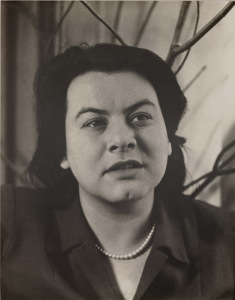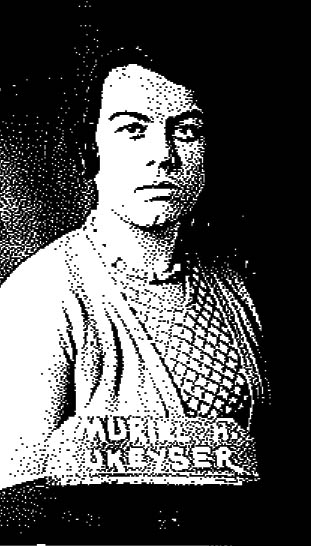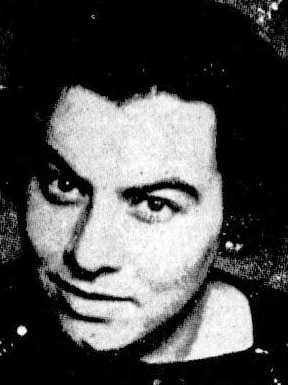Muriel Rukeyser ’1934

“The range and daring of her work, its generosity of vision, its formal innovations, and its level of energy are unequal among twentieth-century American poets. Her poems can be panoramic (yet vividly concrete), intimate, epigrammatic, meditative, sensual, mordantly witty, visionary; never are they quiescent or disenchanted.”
Adrienne Rich, “Muriel Rukeyser for the Twenty-first Century.” (2003)

Muriel Rukeyser was born December 15, 1913, in New York City to a well-off, upwardly mobile Jewish family. As president of the Colonial Sand and Stone Company, her father, a Wisconsin-born construction engineer turned cement company owner, had found success in the post-war New York City building boom in the mid- and late-1920s. Although her mother, a former bookkeeper, claimed descent from the great Rabbi Akiva, the family was almost entirely secular. Rukeyser’s parents were also not intellectuals—she would later write that the only poetry at home was Shakespeare and the Bible—but the books they bought as decorative items—sets of Dickens, Dumas, Hugo, and Balzac—gave her access at an early age to many great works of literature. She attended the private Ethical Culture Fieldston School in the Bronx until 1930 when at age 16 she enrolled at Vassar College.
Rukeyser’s literary interests rapidly found expression. In her sophomore year a classmate, Mary St. John ’34, in a highly critical appraisal of an issue of The Vassar Review, called her “one of our better writers.” Also that year she represented the college at Mount Holyoke in an annual intercollegiate poetry competition, with students from Harvard, Yale, Princeton, Wesleyan, Smith, and Mount Holyoke, whose judges included Amherst College Professor George Frisbie Whicher and the poet Sara Teasdale.
Rukeyser served on the editorial staff of The Vassar Review and The Miscellany News, to which she was a frequent contributor. Her pieces included incisive literary criticism such as her analysis, in a series called “Modern Trends,” of American poetry, which began with categorical certainty: “Contemporary American poetry has divided itself into three trends: acceptation, despair, and hope towards something new and effective or towards death. These motions have their latest origins in three poets: Archibald MacLeish, T. S. Eliot and Robinson Jeffers.” “Hail Muse,” an unsigned characterization of the intercollegiate competition at Mount Holyoke in The Miscellany News for May 18, 1932, is almost certainly by Rukeyser:
“We had hoped that Mnemosyne, given a well-attended funeral procession, would die easily—but she cropped up. We had hoped that John Donne’s poor tortured ghost had died in Cambridge, Mass.—and that the lyrics of the nineties had whistled down the steam-heated wind of college poetry. We had hoped…. The old poems stand, and we can turn to them gravely and with the loved gestures of artistic ritual; but they can not act as substitute for our new comment on the day. The anthologies have been fodder for college magazines long enough…. Intelligent authority comes glibly, as a phrase. It implies knowledge of the history of poetry and its position. Form as well as meaning—but there’s no sense in repeating formulae. Let our college poetry bury its dead and walk away on both its feet.”
Poetry and poets were frequent subjects of Muriel Rukeyser’s campus journalism, but other pieces foreshadowed her lifelong political activism. In 1932, after visiting miners in the Pennsylvania coal district, she wrote stirringly of their plight in “The Color of Coal is Black,” invoking William Blake and, perhaps unconsciously, foreshadowing the lethal white “flour” of silica dust that figures in “Tunnelitis,” in “The Book of the Dead,” the poem sequence on the plight of silica miners and their families in her collection U.S. 1 (1938):
“Sometimes the hills are covered with a sparse mould of grass. But black is the color. The men one meets in the country are likely to be farmers or salesmen; descending the valley, one finds the miners’ uniforms, the small metal lamps clipped to the visors of the their caps, the dark grime of their jobs staining face and hands and sooting their clothes. Flour of industry—here are no pictures of romantically-whitened millers, but ‘the dark Satanic mills.’”
Rukeyser’s father’s business suffered greatly during the Depression, and she was forced to withdraw from Vassar at the end of her sophomore year. This interruption accommodated her growing restlessness, but her Vassar work and acquaintances helped steady her pursuit of a poetics of expressive immediacy and social concern. In the summer of 1932, with three other Misc. editors—Elizabeth Bishop ‘34 and the Clark sisters, Eleanor ‘34 and Eunice ‘33—she founded a literary journal, Housatonic. Its mission was, as an announcement in The Miscellany News declared, to “deal with the culture and traditions of New England in their changing social and economic backgrounds.” Rukeyser served as the journal’s editor for some time after she left Vassar, securing an advertisement in its pages for the American Marxist journal The New Masses and writing about the journal to Ezra Pound, as “somebody who’s been for my eighteen years in New York and subject to that education, wanting to see any one place whole.” “It’s a place magazine,” she told Pound, “that speaks about New England…. Officially, I should be asking you what, from your point of vantage, you see happening to New England when the nucleus breaks…. Our attack is from the place-poem, place-magazine side, after the person-poem, person novel.”
Another incident the following spring, her anonymous contribution to yet another student publication, Con Spirito—founded in early 1933 by, among others, Mary McCarthy ’34, Bishop and the Clarks—reflects Rukeyser’s continuing association with (and her critique of) Vassar. In May 1933, as part of an original production, Now I Know Love—A Mime Sequence: for 1933 A. D., the Vassar Experimental Theatre presented the world premiere of T. S. Eliot’s verse drama Sweeney Agonistes. Eliot collaborated in the production, and Rukeyser apparently attended the lecture and reading from his work the following day in Avery Hall. Tentatively confirmed by McCarthy as by Rukeyser— “Yes, that sounds like Muriel”—the opening lines of “Lecture by Mr. Eliot,” mark the poem as, almost unmistakably, hers:
“Dither and amble and twitter at the brink of time
whispering fragments of a century
sliding among a thousand ghosts of meaning
nudging an emotion for the reason of a rhyme
impaling logic’s strict velocity.
Mr. Panfilo sits and grins
absorbed beyond hope in his own grinning—
collapsing in attempts to make an end
to his idea’s beginning.
The hall is blanched, engrossed
in a stupendous boredom.
The audience crumbles in cerebral whoredom,
devoted lustfully to a conceit’s expansion,
to an obscure line’s scansion.
These Fantastics bow and nod
homage to prosody as God.
Somewhere beyond these windows, China moans,
the rubber heels of statesmen are mirrored in tiling,
in Alabama are beated nine dark boys,
and quenched—while poets practise smiling
contemptuously in the seventh row:
forget their fierce and rapier ways
and forfeit bravery for praise.
Speak poems in articulo…. “
Rukeyser had begun the poems that composed her first published collection, Theory of Flight (1935), while still at college. After Vassar, she took classes at Columbia as well as ground crew lessons at Roosevelt Aviation School on Long Island (her parents barred her, a minor, from flying lessons) that deepened the contents of Theory of Flight—chosen by Stephen Vincent Benét for publication in the prestigious Yale Series of Younger Poets. Concurrent with work on the poems for this collection, in the fall of 1933 she covered the second Scottsboro Trial for the journal of the socialist National Student League, the Student Review, contracting typhoid fever while in an Alabama jail, charged with fraternizing with an African-American.
On her first trip abroad, Rukeyser went to London in 1936, where she met T. S. Eliot and C. Day Lewis, among others, and where she secured an assignment from the English monthly Life and Letters to cover the antifascist Olimpiada Popular, to be held in Barcelona in protest to the Berlin Olympics. On July 17, two days before the games were to start, military insurgents took control of Seville, and on July 19 and 20 they put Barcelona and Madrid under attack. Rukeyser’s train, with Catalans, tourists, and athletes from several European countries aboard, was stopped in a Catalan village outside the city, and by the time she reached Barcelona, the city was a battleground, the Olimpiada was cancelled and the Spanish Civil War was underway.
However anti-climactic, her time in Catalonia was deeply formative for Rukeyser. “These were anarchists,” she recalled in an interview in the early 1970s, “a united front in which anarchists, socialists and communists were within the republic…. It was an extraordinary sight of something that then did not take place…. It was a curious vision of a twentieth-century world which would not take place. It may still, but it has been beaten down in place after place, from Spain to Vietnam and many many places in between.” Her accounts of these days appeared in Life and Letters Today and The New Masses, and over the next several years, Rukeyser worked this experience into her only novel, Savage Coast. The work’s unfinished draft was serially rejected by her publisher’s reader as “one of the worst stretches of narrative I have ever read,” and the book’s female protagonist—Rukeyser herself—seemed to him “too abnormal for us to respect what she sees, hears and feels.” The novel, reconstructed and published by Feminist Press in 2013, was hailed in The New York Times as “a cross-cultural love story Hemingway would have envied for its suddenness.”
Also in 1936, Rukeyser went to West Virginia to conduct interviews and collect evidence about the silicosis outbreak that had killed hundreds of miners. These materials led to her second book, US1, and its centerpiece, the long poem “The Book of the Dead,” a multi-section public indictment of mining company practices that became front-page news in the wake of the tragedy. Rukeyser continued to appear in Poetry, The Nation, the Daily Worker, and The New Republic and to speak at Eastern colleges and universities, appearing in 1939 at Columbia in a panel discussion with W.H. Auden.
She also remained a continuing part of Vassar. Reviewing Theory of Flight in the Miscellany News in December 1935, in what he admitted was “little more than an advertisement,” Assistant Professor of English Alan Porter called her talent “strong and individual; her mind is a contemporary mind; she is engaged, that is to say, in making poetry, in turning the world she experiences into poetry, not in repeating poetic effects from the past.” A year later, Rukeyser spoke to the Miscellany News on her experiences in Barcelona, recalling the quixotic parting words of a leader of the anti-fascist government—soon to be overthrown by Generalissimo Franco’s nationalists— “You have come here to see the People’s Olympic Games, and you have seen the victory of the People’s Front—now it is your duty to go back and tell what you have seen.”
Throughout the ‘30s and ‘40s Muriel Rukeyser continued to give periodic interviews to The Miscellany News, and her work was written about and reviewed by both professors and students in campus publications. In late fall 1940, she returned to the college for a series of four lectures on “Communication and Poetry”: “The Fear of Poetry”; “The Speed of the Image, Poetry and Belief”; “Peace and Poetry”; and “Poetry and Communication.” The lectures were discussed intently in the Miscellany News by animated Vassar students, some uncertain in their considerations, others seeing them, for example, as “a brief, if we may call it that, for the vocabulary and grammar and message of art in the cosmos of fear.”

“The Fear of Poetry” appeared the following year in Dorothy Norman’s social activist journal, Twice a Year, and Rukeyser included all four essays, in edited form, in her definitive critical work, The Life of Poetry (1949). In her 1940 visit, Rukeyser also shared with students her fascination with the American physicist and polymath Josiah Willard Gibbs (1839–1903)—called by Albert Einstein “the greatest mind in American history” and by Rukeyser “the emblem of naked imagination”—about whom she had written a long poem, “Gibbs,” included in A Turning Wind (1939), and whose biography she published in 1942.
By the late 1940s, Rukeyser was a force to be reckoned with—one way or another—in the literary world: outspoken, unconventional in method, politics, and concept of the place and nature of literature, but widely published as a poet, an essayist, a critic, and a social commentator and always busy with teaching, lecturing, broadcasts, and prizes. She was also increasingly politically worrisome; the FBI, having begun a file on her in 1943, maintained it until her death. She had a child out of wedlock in 1947 by a man whose identity she never revealed despite the social stigma attached to single motherhood, an experience she also wrote about.

At the invitation of the departments of English, anthropology, philosophy, and physics, Rukeyser visited Vassar for over a week in 1949, attending classes, meeting with students, and lecturing on “The Life of Poetry.” Her visit was a major event of that academic year. She was described by a student reporter as “one of America’s foremost poets… a person of great warmth, vitality, and understanding. A friendliness and sincerity are evident in her manner and conversation.” She spoke in several classes, met with student editors of campus publications, led a discussion with the Student Liberal Association about the United States as a world power, and met with individual students by appointment.
Rukeyser’s unyielding radicalism and the distinctive incorporation of social issues and concerns in her writing came into increasing conflict with the apolitical, introspective trends in the arts and with the rise of McCarthyism in the late 1940s and the 1950s. Nonetheless, she remained popular at her alma mater. She was mentioned as a former “Misc-ite” in attempts to attract new writers to The Miscellany News in the 1960s, and her poetry was quoted in editorials. In 1961, students performed her dramatic piece, “The Colors of the Day,” written for Vassar’s centennial Alumnae Day, in the Outdoor Theatre.
Recovering from a stroke she suffered in 1964, the ever-political Rukeyser became known in the later ‘60s and ‘70s for her outspoken feminism and her opposition to American involvement in Vietnam. In 1967, student leaders at colleges throughout the country sent a letter to President Johnson protesting the war. Rukeyser was among a number of alumnae and former members of the faculty who signed a statement in The Miscellany News criticizing Vassar’s absence from the signatories. She flew to North Vietnam on an unofficial peace mission in 1972, and she took part in anti-war demonstrations back home. In 1975, recently elected president of PEN’s American branch, she flew to South Korea to protest the political imprisonment of the poet Kim Chee Ha, standing for days outside his prison gates.
On February 12, 1980, Muriel Rukeyser suffered another stroke and died at the Manhattan home of her literary agent and longtime partner, Monica McCall. An obituary in The New York Times the following day examined her career, noting the range of her public concerns, “from the Scottsboro trial of 1932 through the Spanish Civil War to the plight of Kurdish Socialists executed in Iran last year.” The obituary also cited the appraisal of Rukeyser’s work by Thomas Lask in a review of The Collected Poems (1978): “Poetry was never an artifice to Muriel Rukeyser, never a decoration on life…. The woman and the poet were one. She was always committed. What that commitment meant to her is the substance of her richly rewarding book.”
Related Articles
Sources
Tim Dayton, Murial Rukeyser’s the Book of the Dead, University of Missouri Press, 2003.
Gary Fountain, Remembering Elizabeth Bishop, The University of Massachusetts Press, 1994.
Catherine Gander, Muriel Rukeyser and Documentary: The Poetics of Connection, Edinburgh University Press, 2013.
Alan M. Wald, Exiles from a Future Time: the Forging of Mid-Twentieth Century Literary Left, University of North Carolina Press, 2002.
Jan Heller Levi, “Muriel Rukeyser,” in Jay Panini and Phillip W. Leininger, eds., The Oxford Encyclopedia of American Literature, vol. 1, Oxford University Press, 2004.
Gigliola Sacercdoti Mariani, “’Those men and women/Brave, setting up signals across vast distance,’” HOW2, vol.2, no.1, Spring 2003, Arizona State University.
Mary McCarthy, How I Grew, Harcourt Brace Jovanovich, 1987.
Kyle Paoletta, “Savage Coast: Rowena Kennedy-Epstein on Muriel Rukeyser’s political and emotional vision,” Harpers Magazine, June 26, 2013.
Adrienne Rich, “Muriel Rykeyser for the Twenty-first Century, A Human Eye: Essays on Art in Society, 1997–2000, W. W. Norton & Company, 2009
Wolfgang Saxon, “Muriel Rukeyser, Poet of Protest, Dies,” The New York Times, February 13, 1980.
“Muriel Rukeyser Speaks on “The Life of Poetry,” The Vassar Chronicle, vol. VII, no. 7, November 12, 1949.
“Contributors’ Column: The Color of Coal is Black,” The Vassar Miscellany News, vol. XVI, no. 31, March 12, 1932.
“Hail Muse,” The Vassar Miscellany News, vol. XVI, no. 45, May 18, 1932.
Muriel Rukeyser, “Modern Trends: American Poetry,” The Vassar Miscellany News, vol. XVI, no. 46, May 21, 1932.
“Four Members of News Board to Start Magazine,” The Vassar Miscellany News, vol. XVI, no. 47, May 25, 1932.
“The Hand Refuses….,” The Vassar Miscellany News, vol. XXV, no. 12, November 2, 1940.
TF, CJ 2014, 2015